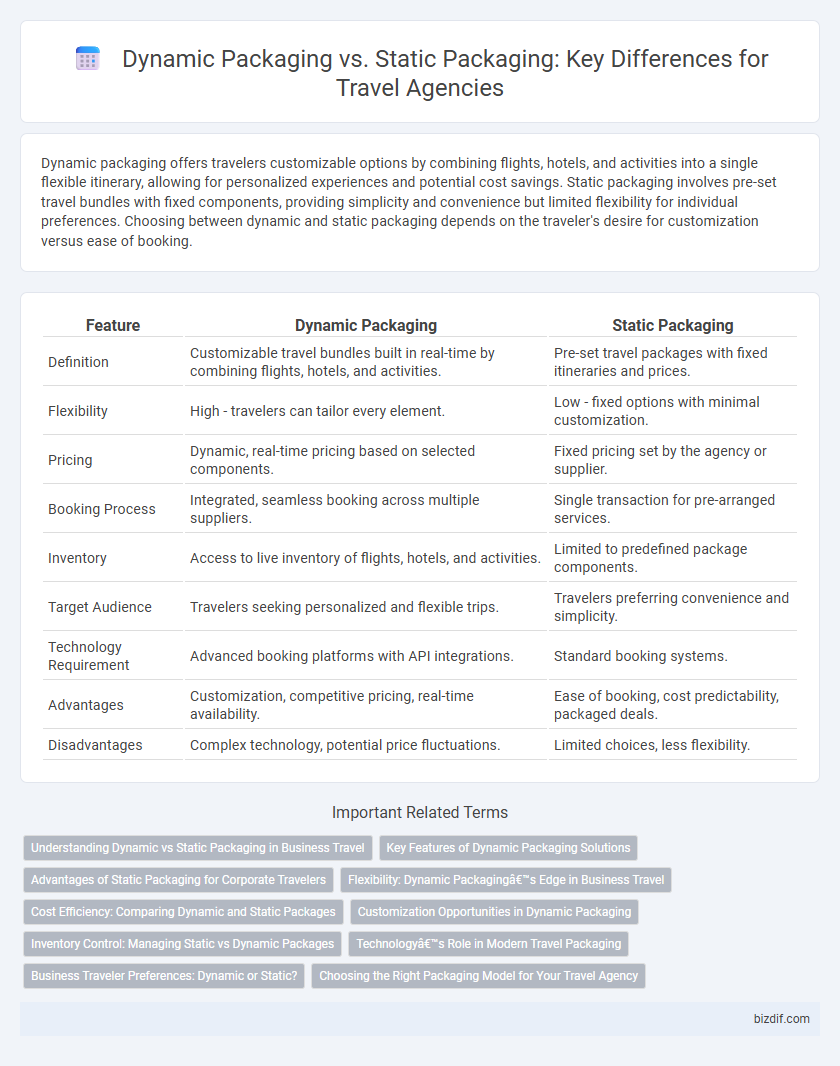Dynamic packaging offers travelers customizable options by combining flights, hotels, and activities into a single flexible itinerary, allowing for personalized experiences and potential cost savings. Static packaging involves pre-set travel bundles with fixed components, providing simplicity and convenience but limited flexibility for individual preferences. Choosing between dynamic and static packaging depends on the traveler's desire for customization versus ease of booking.
Table of Comparison
| Feature | Dynamic Packaging | Static Packaging |
|---|---|---|
| Definition | Customizable travel bundles built in real-time by combining flights, hotels, and activities. | Pre-set travel packages with fixed itineraries and prices. |
| Flexibility | High - travelers can tailor every element. | Low - fixed options with minimal customization. |
| Pricing | Dynamic, real-time pricing based on selected components. | Fixed pricing set by the agency or supplier. |
| Booking Process | Integrated, seamless booking across multiple suppliers. | Single transaction for pre-arranged services. |
| Inventory | Access to live inventory of flights, hotels, and activities. | Limited to predefined package components. |
| Target Audience | Travelers seeking personalized and flexible trips. | Travelers preferring convenience and simplicity. |
| Technology Requirement | Advanced booking platforms with API integrations. | Standard booking systems. |
| Advantages | Customization, competitive pricing, real-time availability. | Ease of booking, cost predictability, packaged deals. |
| Disadvantages | Complex technology, potential price fluctuations. | Limited choices, less flexibility. |
Understanding Dynamic vs Static Packaging in Business Travel
Dynamic packaging in business travel allows companies to customize and combine flights, hotels, and transportation in real-time, offering flexibility and cost savings tailored to specific itineraries. Static packaging involves pre-set travel bundles with fixed components and prices, simplifying booking but limiting customization and adaptability to changing business needs. Embracing dynamic packaging enhances efficiency and responsiveness in corporate travel management by enabling personalized solutions aligned with company policies and traveler preferences.
Key Features of Dynamic Packaging Solutions
Dynamic packaging solutions enable travelers to customize their trips by combining flights, accommodations, and activities in real-time, offering flexibility and personalized options. Key features include real-time inventory access, instant price updates, and seamless integration with multiple suppliers, which enhance user experience and optimize cost savings. These solutions also support last-minute changes and tailored itineraries, making them ideal for modern travel demands.
Advantages of Static Packaging for Corporate Travelers
Static packaging offers corporate travelers fixed itineraries with predetermined prices, ensuring budget predictability and simplifying expense approvals. These packages include carefully selected combinations of flights, hotels, and transportation, minimizing the need for extensive planning. This stability reduces last-minute changes and enhances time efficiency, crucial for busy business professionals.
Flexibility: Dynamic Packaging’s Edge in Business Travel
Dynamic packaging offers unparalleled flexibility by allowing business travelers to customize flights, hotels, and ground transportation in real-time based on changing schedules and preferences. Unlike static packaging, which locks in predetermined service combinations, dynamic packaging adapts instantly to last-minute adjustments and corporate travel policies. This adaptability enhances cost efficiency and traveler satisfaction, making dynamic packaging the preferred choice for agile business travel management.
Cost Efficiency: Comparing Dynamic and Static Packages
Dynamic packaging enhances cost efficiency by allowing travelers to customize components like flights, hotels, and activities in real-time, often securing better deals through bundled discounts and last-minute offers. Static packaging offers fixed, pre-set itineraries with locked-in prices, which may limit flexibility but provide predictable budgeting for travelers. Travel agencies leveraging dynamic packages benefit from increased profit margins by optimizing supplier rates and minimizing unsold inventory compared to the traditional cost structures of static packages.
Customization Opportunities in Dynamic Packaging
Dynamic packaging offers superior customization opportunities by allowing travelers to tailor flights, accommodations, and activities in real time based on preferences and budget constraints. Unlike static packages that offer pre-set itineraries, dynamic packaging integrates various travel components through advanced technology to create personalized experiences. This flexibility enhances customer satisfaction and can lead to increased revenue for travel agencies by meeting diverse traveler needs more effectively.
Inventory Control: Managing Static vs Dynamic Packages
Dynamic packaging offers superior inventory control by allowing real-time aggregation of flight, hotel, and car rental options, enabling travel agencies to tailor packages based on current availability and pricing. Static packaging relies on pre-set combinations of services, limiting flexibility and often resulting in outdated or less competitive offerings. This dynamic approach reduces inventory risk and maximizes profit margins through adaptive resource management.
Technology’s Role in Modern Travel Packaging
Dynamic packaging leverages advanced algorithms and real-time data integration to custom-build travel itineraries, enhancing personalization and flexibility for travelers. Static packaging relies on pre-assembled, fixed travel components, limiting customization but offering simplicity and predictable pricing. Technology enables seamless access to diverse inventory and instant price adjustments, empowering travel agencies to deliver tailored experiences efficiently in modern travel packaging.
Business Traveler Preferences: Dynamic or Static?
Business travelers often prefer dynamic packaging due to its flexibility, allowing customization of flights, hotels, and transport tailored to tight schedules and specific needs. Static packaging, with its fixed itineraries and predetermined components, appeals less to this segment as it lacks adaptability for last-minute changes or personalized preferences. Data indicates that dynamic packaging solutions enhance convenience and cost-efficiency, making them the preferred choice for corporate travel planning.
Choosing the Right Packaging Model for Your Travel Agency
Dynamic packaging allows travel agencies to customize trips by combining flights, hotels, and activities in real-time, offering flexibility and personalized experiences that enhance customer satisfaction. Static packaging involves pre-set travel bundles with fixed prices, providing ease of booking and cost savings through bulk negotiations with suppliers. Selecting the right packaging model depends on your agency's target market, technological capabilities, and the demand for customization versus convenience.
Dynamic packaging vs Static packaging Infographic

 bizdif.com
bizdif.com